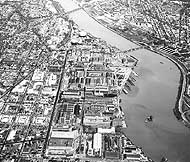
The World War II years brought on the Navy Yard's final great expansion. Two additional land parcels took its western boundary all the way to First Street. Several more large buildings were constructed, most notably in the northeastern and western parts of the facility, to allow the Yard to keep up with wartime demands for weapons production as well as scientific and engineering development.
These technological activities increasingly became the Yard's main functions after the War. Naval guns continued to be built, but these were nearly all smaller weapons, rapid-firing five-inch and three-inch types optimized for anti-aircraft purposes. Countering faster aircraft and submarines, and a generally more-complex tactical environment, required ever-more-capable radar, sonar, weapons directors, and other optical and electronic devices. Existing Naval Gun Factory shops were modified, and new ones established, to develop and produce this new equipment.
During the 1950s, guns began to be displaced by guided missiles aboard the Navy's ships, and the Gun Factory took up the manufacture of these weapons, and especially of their launchers. Late in the decade, this change in ordnance technology gave the Yard a new name: the Naval Weapons Plant. However, by this time its days as an industrial site were numbered. Weapon and electronics work was now mainly going to private enterprise and Government operated facilties were being phased out. The Naval Weapons Plant's assigned production work was completed in 1961, and the next two years saw its disestablishment and the beginning of the Navy Yard's conversion to other purposes. Washington, D.C., never much of an industrial town, had lost its largest manufacturing operation.
This page features overall views of the Washington Navy Yard taken from 1940 into the early 1960s.
For links to other overall views of the Washington Navy
Yard, see:
| If you want higher resolution reproductions than the Online Library's digital images, see: "How to Obtain Photographic Reproductions." |
Click on the small photograph to prompt a larger view of the same image.
For links to other overall views of the Washington Navy
Yard, see:
| If you want higher resolution reproductions than the Online Library's digital images, see: "How to Obtain Photographic Reproductions." |
Page made 17 February 2002